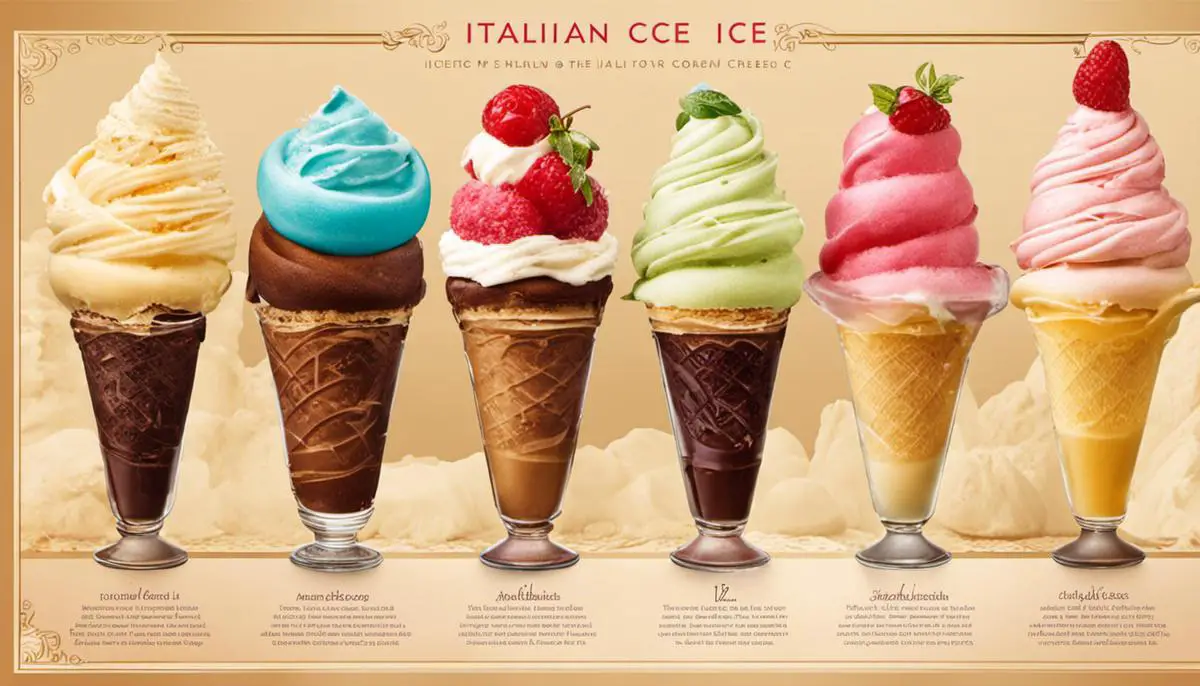Welcome to the world of exquisite Italian Gelato, a delicacy that embodies the rich culinary tradition of Italy. Known for its silky texture, intense flavor, and relatively low-fat content, Gelato, the Italian version of ice cream, has earned global admiration. This article offers an in-depth exploration of the captivating history of Gelato, from its aristocratic origins to its present-day popularity. It further delves into the traditional processes that give Gelato its distinct quality, contrasting it with other forms of ice cream. Finally, we embark on a flavor adventure, discovering Gelato’s vast range of tastes and unique combinations.
Table of Contents
The Gelato History of Italian Ice Cream

Italian Ice Cream: Origin and Evolution
The foundations of modern Italian Ice Cream, or Gelato, can be traced back to the frozen desserts served in the aristocratic classes of ancient Rome and Egypt. These desserts were made of snow and ice brought down from the tops of mountains and preserved in straw-covered pits called ice houses. The snow and ice were then sweetened with honey and flavored with fruits and juices.
The term gelato, derived from the Italian word “gelare,” which means “to freeze,” did not appear until centuries later. The original concept of gelato was refined in the 16th century by the Italian architect and culinary connoisseur Bernardo Buontalenti. Buontalenti presented his “crema gelata” or “frozen cream” to the court of Catherine De Medici during a banquet. It was a more svelte version of the ancient dessert, resembling more closely what we today know as gelato.
Gelato: A Uniquely Italian Experience
The craft of gelato preparation was elevated to a true art form in Italy. During the Renaissance period, the Italians began to innovate and experiment with the dessert. They created new flavors, mixing fruit and wine with sugar, cream, and eggs to create a variety of unique and delicious combinations. In the 17th century, gelato began to gain popularity outside the confines of the court and moved into the public domain, thanks to the efforts of the Sicilian Procopio Cutò. He opened a café in Paris, introducing his gelato to a broader audience.
The Spread of Gelato Across the Globe
Gelato’s popularity continued to grow, and by the 1900s, the dessert had begun to make its mark beyond Italy. Italian immigrants who traveled to various parts of the world took their love of gelato with them. They introduced their traditional methods of making this dessert, hence beginning the spread of gelato to different corners of the globe. Today, gelato is no longer limited to the classic flavors of vanilla, chocolate, and strawberry but has instead become a canvas for artisanal creativity and innovation.
Gelato: An Enduring Tradition
Despite the new flavors and the introduction of mechanical production methods, the traditional process of making gelato remains largely the same. The dessert is still crafted with care, highlighting the focus on the quality of the ingredients and the precision of the art. In Italy, gelatai or gelato makers are esteemed professionals who often learn their craft from a family business or a gelato university, evidence of just how seriously the Italians take their gelato.
Delving into the Names of Italian Ice Creams
Traditional and inventive ice cream flavors are at the heart of Italian gelato culture, with each name corresponding to a unique mix of ingredients and profiles. From classic favorites such as ‘Crema’ (Cream), ‘Frutti di Bosco’ (Mixed Berries), ‘Cocco’ (Coconut), ‘Nocciola’ (Hazelnut), ‘Cioccolato’ (Chocolate), ‘Limone’ (Lemon), to ‘Fragola’ (Strawberry), to contemporary additions like ‘Tiramisu’, ‘Zabaione’, and ‘Bacio’ (chocolate hazelnut), the list continues to grow. This stand as a testament to the creative spirit that continually redefines Italian gelato.

The Authentic Making Process of Gelato
The Artisanal Process: Crafting Flavor Masterpieces
Creating true Italian gelato requires careful attention to detail and a commitment to maintaining the authentic practices that set it apart from other ices cream. This deliberate process gives birth to a dessert that’s not only rich and decadent but also dense in flavor and texture – marking the real essence of Italian gelato’s uniqueness.
The Artisan Method: Sculpting Flavors
The creation of this frozen delight commences with crafting a perfect base that includes prime ingredients such as milk, sugar, and occasionally, egg yolks. The quality of these fundamental ingredients greatly impacts the final gelato taste. The art of gelato making does not rely on heavy cream, which is often found in traditional ice cream. This distinct trait underlines its lower fat content while magnifying its flavor intensity.
Churning the Flavors: Introducing Lower Amounts of Air
One of the main differences between gelato and regular ice cream is the proportion of air introduced during the churning process. Gelato contains a much smaller percentage of air, often ranging between 20-30%. In contrast, commercial ice creams can contain as much as 50% air. This difference in churning and air incorporation lends gelato its signature dense and elastic texture.
The Serving Method: Enhancing the Gelato Experience
The temperature at which gelato is served also contributes to its unique texture and flavor. While ice cream is typically served at a frosty temperature, gelato is presented at a slightly warmer range, typically between 10 -15 degrees Fahrenheit. This warmer serving temperature allows for the richness of the flavors to fully bloom, delivering an intensely satisfying experience with each bite.
The Balance of Ingredients: Mastering the Gelato Recipe
Despite containing less cream and fat than ice cream, gelato offers a mouthfeel that is creamier and smoother. The balance of ingredients here plays a significant role, as the lower fat content allows the flavors of gelato to shine through more prominently. The high-quality, often locally sourced ingredients – such as fresh fruit purees, artisan chocolate, and roasted nuts – lend the gelato its opulent flavor profile.
Artisanal Approach: Prioritizing Quality over Quantity
Genuine gelato is often made in small quantities and sold within the same day to guarantee its freshness and high quality. This process distinctly separates gelato from various commercially produced ice creams that are made in large quantities and stored for extended periods. The focus on daily production typifies the Italian dedication to quality and freshness, both vital elements in the tradition of gelato making.

Distinguishing Characteristics: Gelato Vs. Ice Cream
Unique Traits: Gelato Vs. Ice Cream
Starting with the ingredients, gelato and ice cream have a few common components like milk, sugar, and flavorings. However, the proportions differ significantly. Ice cream generally contains more cream than milk, whereas gelato uses a higher ratio of whole milk to cream, yielding a denser and more potent flavor.
A critical difference also lies in the churning method. Ice cream is mixed at a rapid speed, which introduces a lot of air and increases its volume, leading to a light, airy texture. In contrast, gelato is mixed slowly, incorporating less air and creating a denser, richer texture.
Finally, the serving temperature deeply influences the overall experience. Ice cream is usually served at a temperature of 10°F to 0°F, giving it a solid, firm texture. In contrast, gelato is served at slightly warmer temperatures, typically between 21°F to 17°F, which is why it stays softer and silkier.
Even though ice cream and gelato might share similar flavors, the taste of each varies due to the differing amounts of fats and air. As gelato holds less fat and less air than ice cream, its core flavors shine through, offering gelato a distinctively richer taste and a more vivid flavor sensation in the mouth.
Understanding Gelato: Beyond Simple Ice Cream
The term ‘gelato’ might be misconstrued as simply being the Italian language equivalent of ‘ice cream’. However, this isn’t entirely accurate. While ‘gelato’ does indeed mean ‘frozen’ in Italian, the method of creation and the final product don’t exactly match what we commonly categorize as ice cream. Gelato brings to the table a distinctive dining experience, being denser, creamier, and more concerned with pronounced flavors than typical American ice cream.
Commonly, people mistake rich taste to mean a higher calorie content. However, interestingly enough, gelato is actually healthier than regular ice cream. This difference stems from a higher proportion of milk to cream, leading to lower fats, and fewer calories due to lesser incorporation of air during the churning procedure.
When it comes to Italian linguistics, ‘gelato’ specifies a particular style of frozen treat, not merely a blanket term for any ice cream. There are distinct names for different kinds of chilled desserts in Italy, such as ‘sorbetto’ (sorbet), ‘granita’ (semi-frozen dessert made from sugar, water, and various flavorings), and ‘semifreddo’ (semi-frozen desserts).
To sum up, gelato is not merely an Italian variant of ice cream. Its specialized creation process, enhanced taste and texture, and an inherent indulgence set it apart from mainstream ice cream, making it a unique delicacy in the realm of frozen treats.

Popular Flavors and Unique Combinations in Gelato
Classic Gelato Flavors
The exotic and wide-ranging flavor profile of gelato, often mistaken as simply Italian ice cream, marries traditional elements with innovative ones. Standard flavors include ‘Cioccolato’ (chocolate), ‘Vaniglia’ (vanilla), ‘Fragola’ (strawberry), ‘Limone’ lemon), and ‘Caffè’ (coffee). ‘Stracciatella’ is a standout, originating from Bergamo, featuring creamy vanilla gelato streaked with chocolate pieces. Another timeless flavor is ‘Nocciola’ (hazelnut), mixing rich nutty undertones with the creamy sweetness of the gelato base. Moreover, flavors like ‘Pistacchio,’ ‘Amarena’ (sour cherry), ‘Mandorla’ (almond), and ‘Zuppa Inglese’ (a concoction of Alchermes liqueur, custard, and sponge cake) are particularly relished in Italy.
Popular Gelato Flavor Combinations
The charm and appeal of gelato lie not only in its standalone flavors but also in the unique combinations created by blending different flavors. For example, ‘Bacio,’ meaning ‘kiss,’ is a decadent mix of chocolate and hazelnut, often paired with ‘Stracciatella’ for an explosion of chocolaty goodness. ‘Menta e Cioccolato’ combines refreshing mint with chocolate. ‘Fior di Latte,’ a milky flavor, is often paired with fruit flavors like ‘Fragola’ for a creamy fruit creation.
A common practice is mixing ‘Frutti di Bosco’ (mixed berries) with ‘Limone’ for a refreshing, tangy treat. Also, ‘Caffè’ and ‘Nocciola’ is a favorite duo, marrying the bitter and robust notes of coffee with the smooth nuttiness of hazelnut.
Experimental Gelato Flavors
Experimental flavors push the boundaries of gelato creativity. Adventurous flavor profiles include ‘Gorgonzola e Miele’ (blue cheese and honey), ‘Sesamo Nero’ (black sesame), ‘Riso’ (rice), ‘Zenzero e Cannela’ (ginger and cinnamon), and ‘Birra’ (beer). As flavor innovation continues to progress in the gelato industry, offerings like ‘Basilico’ (basil), ‘Rosmarino’ (rosemary), ‘Peperoncino’ (chili), and ‘Prosecco’ (Italian sparkling wine) have become increasingly popular.
Pairing Gelato with Italian Beverages and Desserts
The Italian culinary tradition provides ample opportunities to pair gelato with authentic beverages and desserts. A favorite combination is ‘Affogato’ – a hot shot of espresso poured over a scoop of vanilla or ‘Caffè’ gelato, causing a delicious creamy-melting effect. ‘Frizzante al Limone’ pairs a sparkling lemon soda with a scoop of ‘Limone’ gelato for a refreshing summer drink.
When gelato is paired with classic Italian desserts, the results can be heavenly. ‘Tiramisu’ can be served with ‘Mascarpone’ or coffee-flavored gelato, while ‘Panna Cotta’ can be perfectly accompanied by ‘Frutti di Bosco’ for a fruity contrast. Rich, dense ‘Torta Caprese’ (Chocolate and Almond cake from Capri) pairs exceptionally well with ‘Nocciola’ or ‘Pistacchio’ gelato.
Italian gelato, with its traditional, popular, and experimental flavors and unique combinations, offers an unlimited flavor experience that consistently delights ice cream enthusiasts worldwide.

Final Thoughts on Italian Gelato
Through the historical journey, intimate look into the making process, and exploration of the diverse flavors, we have deepened our understanding and appreciation of the Italian dessert Gelato. A culinary intersection where science meets art, Gelato stands as a testament to the careful craftsmanship and innovative spirit of Italian culture. More than just a delectable dessert, it is a cultural artifact, narrating stories of the place, time, and people, that are enveloped within its creamy layers. We hope this insight fuels your love for Gelato, inspiring you to savor this Italian gem in all its glorious shades and flavors.
Related Reading
Unveiling the Secret Behind Red Hot Dogs – The Fascinating Story of Why They’re Red
Discover The Top 7 Low Sodium Hot Dogs – Enjoy Healthier Alternatives Today!
Host Like a Pro: A Guide to the Most Popular Beers in America





